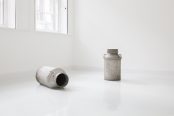[dropcap style=”font-size:100px; color:#992211;”]S[/dropcap]lugs the soize of CAAAATS, there were….
And phylloxera, mildew, botrytis and blackspot. That’s just a couple of the hazards lying in wait for the plucky adventurer hoping to harvest their own grapes. They’re vulnerable little critters, but it turns out there may be a way to turn them into hard-arse, shirt-off immuno-balls of juicy proto-wine.
Bring it, we say, bring it.
From protecting our most valuable works of art to enabling smartphone displays, glass has become one of our most important materials. Making it even more versatile is the next challenge. Developing new glass compositions is largely a time-consuming, trial-and-error exercise. But now scientists have developed a way to decode the glass “genome” and design different compositions of the material without making and melting every possibility. Their report appears in ACS’ journal Chemistry of Materials.
As is true for any agricultural producer, vineyard owners need to prevent pathogens from harming their crops to stay in business. For many of them, this means applying synthetic pesticides. Out of concern for these substances’ potential effects on water, soil and human health, some winemakers have turned to more natural methods. One approach scientists are exploring involves the use of UV-C light, which studies have shown increases grapes’ production of stilbenoids. Some of these phenolic compounds have been associated with natural disease resistance. Raúl F. Guerrero from the Andalusian Institute of Agricultural and Fisheries Research and Training (IFAPA) and colleagues wanted to explore how daily doses of pre-harvest UV-C light would affect grapes’ stilbenoid content.
associated with natural disease resistance. Raúl F. Guerrero from the Andalusian Institute of Agricultural and Fisheries Research and Training (IFAPA) and colleagues wanted to explore how daily doses of pre-harvest UV-C light would affect grapes’ stilbenoid content.
The researchers tested one set of grapes exposed to five minutes of UV-C light every day for three days before harvesting and compared them with another set of grapes that only received one five-minute dose. The latter technique had previously been optimized in grapes. The set that received multiple treatments showed an 86-fold increase in stilbenoid concentrations over the fruit that only got one application of UV-C. The three-day, pre-harvest treatment also affected texture, color and other characteristics, but the researchers say that the grapes were still of good quality.
Source: Eurekalert/American Chemical Society
Image: Mattnagy0/Pixabay

Some of the news that we find inspiring, diverting, wrong or so very right.




















